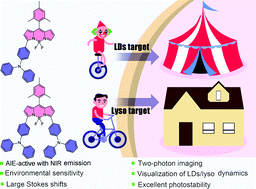Engineering BODIPY-based near-infrared nanoparticles with large Stokes shifts and aggregation-induced emission characteristics for organelle specific bioimaging†
Abstract
Lipid droplets (LDs) and lysosomes, as two important subcellular organelles, play specific and indispensable roles in various cellular processes. The development of efficient LD- and lysosome-specific fluorescent bio-probes is of great importance. However, current commercial lipid droplet- (LD) and lysosome-specific fluorescent specific bio-probes often suffer from the aggregation-caused quenching (ACQ) effect, short absorption and emission wavelengths, poor photostability and low specificity. Herein, a typical ACQ luminogen BODIPY was directly conjugated to strong electron donating triarylamine units at its α-positions, giving near-infrared (NIR) fluorescent materials TPAB and 2TPAB with aggregation-induced emission (AIE). Both TPAB and 2TPAB nanoparticles were obtained by self-assembly, and showed NIR emissions, large Stokes shifts, good photostability and two-photon absorption. These nanoparticles presented remarkable bioimaging performances and were shown to specifically localize in LDs or lysosomes, respectively, depending on the number of triarylamine units attached. They have been successfully used to detect endogenous LD overproduction, and monitor abnormal activities of LDs/lysosomes, as well as real-time track the lipophagy process in cells. Their far NIR emission and two-photon excitation further supported their promising bioimaging application for lipid droplet tracking in liver tissue and live zebrafish larvae. Our work here enriches BODIPY based NIR AIE dyes and provides organelle specific bio-probes which are superior to currently used commercial ones.



 Please wait while we load your content...
Please wait while we load your content...